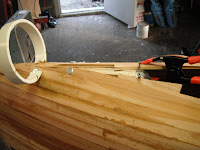 Okay, alright, time for me to grab a beer! I'm caught up on the posts! BRB... Man, it took me a room temperature bottle conditioned Grand Crux homebrew with an excellent head to realize that I had NO reggae on! WTF? On goes Linton Kewesi Johnson Dreadbeat and Blood. Great album!
Okay, alright, time for me to grab a beer! I'm caught up on the posts! BRB... Man, it took me a room temperature bottle conditioned Grand Crux homebrew with an excellent head to realize that I had NO reggae on! WTF? On goes Linton Kewesi Johnson Dreadbeat and Blood. Great album!So like in this pic I'm cutting away 1/2" from the centerline with a utility knife. In a few passes the cedar just peels away. Caution is recommended in this process. NEVER HAVE ANY HUMAN FLESH ON THE DOWNWARD STROKE OF THE BLADE.
 Then my Pop used that centerline guide stencil that you see at his left hand to mark where the centerline is from on the form to the top of the canoe. There is a notch in the stencil to allow for the cedar planks to set in. Basically we just connected the dots with the straightedge and my chalk line was almost exact! We brushed that off and used a ball point pen to mark the centerline.
Then my Pop used that centerline guide stencil that you see at his left hand to mark where the centerline is from on the form to the top of the canoe. There is a notch in the stencil to allow for the cedar planks to set in. Basically we just connected the dots with the straightedge and my chalk line was almost exact! We brushed that off and used a ball point pen to mark the centerline. Then we rough chiseled out most of the wood to about an 1/8th of the centerline. After that I found that raising the wood up off of the forms with a few wedges as I went along with the hand plane worked great! ****NOTE go get yourself a LIE NIELSON low angle hand plane!!**** You will never touch that Stanley again. The Stanley is a great plane, don't get me wrong, but the LIE NIELSON will get you through the tough glued spots much easier just like a wood surfboard will get you through that chop and into the next section of the wave better, the Lie Nielson will do you right. I planed the wood to 92 degrees perpendicular to allow for the later planks to set in easier to the molds. I tell ya, this process may remove some skin off your knuckles and may be tiresome, you just gotta do it!!! I was taking many breaks to sharpen my tools! It will give you a break from the monotony with more monotony! LOL Sharpening sucks! Where are my interns?!?!?!?
Then we rough chiseled out most of the wood to about an 1/8th of the centerline. After that I found that raising the wood up off of the forms with a few wedges as I went along with the hand plane worked great! ****NOTE go get yourself a LIE NIELSON low angle hand plane!!**** You will never touch that Stanley again. The Stanley is a great plane, don't get me wrong, but the LIE NIELSON will get you through the tough glued spots much easier just like a wood surfboard will get you through that chop and into the next section of the wave better, the Lie Nielson will do you right. I planed the wood to 92 degrees perpendicular to allow for the later planks to set in easier to the molds. I tell ya, this process may remove some skin off your knuckles and may be tiresome, you just gotta do it!!! I was taking many breaks to sharpen my tools! It will give you a break from the monotony with more monotony! LOL Sharpening sucks! Where are my interns?!?!?!? My Pop just had is left eye done for cataracts. He sees excellent now! Looks like a nice straight line!
My Pop just had is left eye done for cataracts. He sees excellent now! Looks like a nice straight line! Whatcha think there POP?
Whatcha think there POP?



















